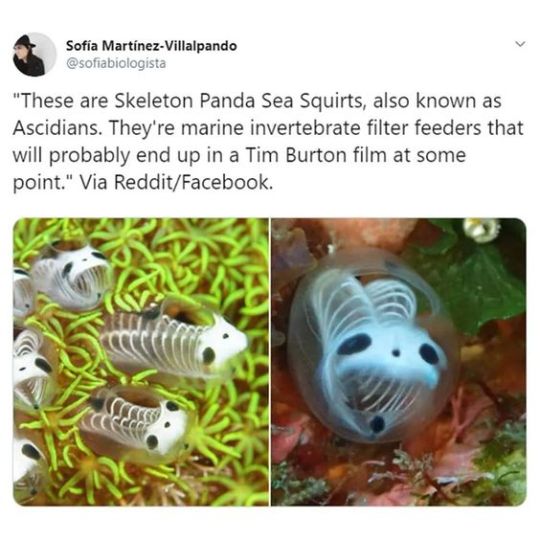#marine invertebrates
Text
Me: marine invertebrates are so interesting. I want to be a marine biologist.
Me in the ocean when my foot touches something:

4K notes
·
View notes
Text
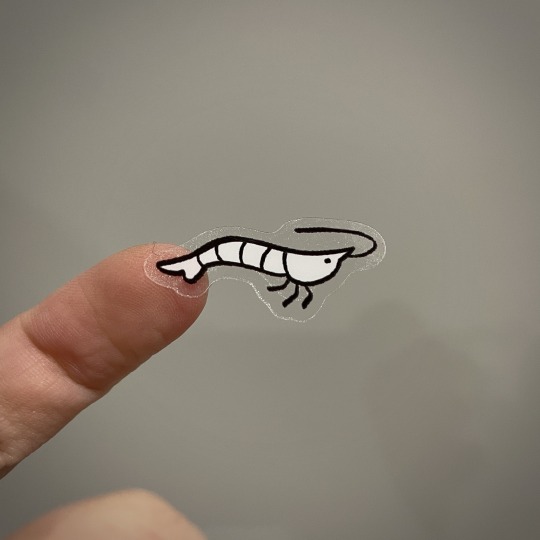
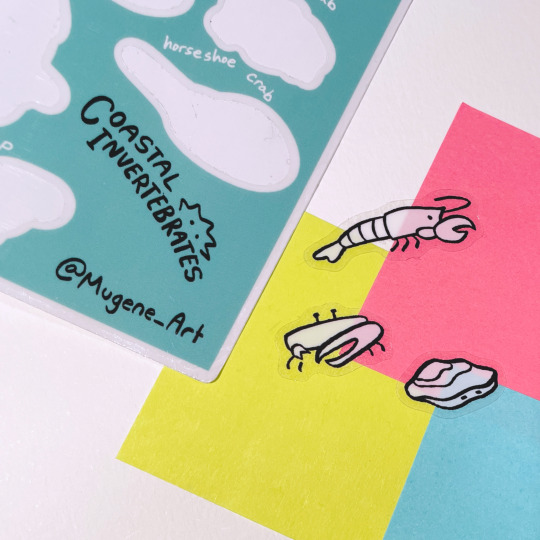

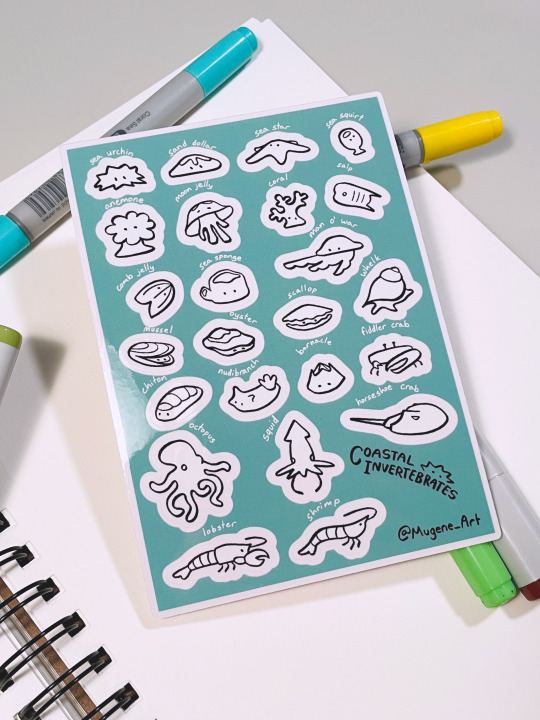
#marine invertebrates#marine biology#invertebrates#shrimp#horseshoe crab#nudibranch#coral#squid#sea anemone#cnidarians#echinoderms#crustacean#mollusk#molluscs#tunicate#sea creatures#sea animals#biology#sticker sheet#stickers#clear stickers#artists on etsy#artists on tumblr#mu's wares
745 notes
·
View notes
Text


aquatic animal illustrations for friends
#art#artists on tumblr#mixed media#collage#acrylic painting#colored pencil#traditional art#fish#fishblr#fish art#polychaete#marine biology#freshwater fish#marine fish#marine invertebrates#wormart
901 notes
·
View notes
Text

I randomly encountered this pic from some kid from 2014's powerpoint presentation and the layout was really familiar so I knew what I had to do
1K notes
·
View notes
Text
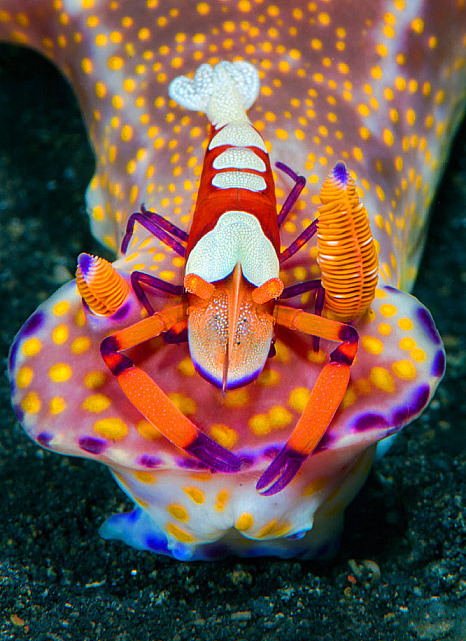
Emperor shrimp (Periclimenes imperator) hitchhiking on large t-bar nudibranch (Ceratosoma trilobatum)
Photo by Alex Mustard
#emperor shrimp#shrimp#colorful shrimp#periclimenes#periclimenes imperator#t-bar nudibranch#nudibranch#ceratosoma#ceratosoma trilobatum#marine#marine life#marine invertebrates#ocean#sea#orange#nature#marine animals#sea creatures
1K notes
·
View notes
Text
can i please have everyone's best marine invertebrate memes (Porifera, Cnidaria, Arthropoda, Mollusca, Annelida and Echinodermata) for my presentation
if i dont get to have a little fun for the thing thats worth 60% of the module what even am i doing at uni
429 notes
·
View notes
Text
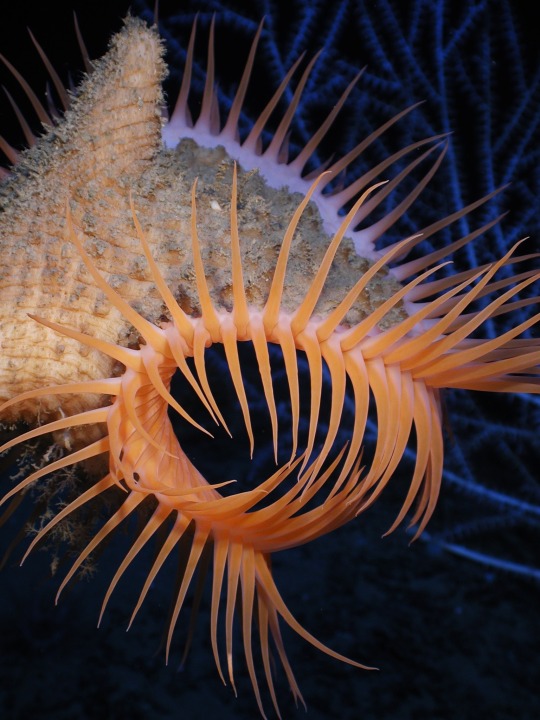
Have you ever seen a venus flytrap anemone? Members of the genus Actinoscyphia, these critters resemble their namesake plant but are actually marine invertebrates related to jellyfish. They can be found on the seafloor at depths of up to about 7,000 ft (2,133 m), where they lie in wait for passing food. These anemones use their tentacles to catch and consume detritus (decomposing organic waste) that's carried by the current. Growing as much as 1 ft (0.3 m) in length, their tentacles are lined with stinging nematocysts.
Photo: NOAA Photo Library, CC BY 2.0, Wikimedia Commons
#natural history#nature#anemone#sea life#science#marine life#ocean life#marine biology#fact of the day#invertebrates#marine invertebrates#cool animals#noaa
467 notes
·
View notes
Text
We were trying to take nice pictures of this sea gooseberry, but no, he insisted on breakdancing.
Over time the gooseberry eventually straightened out.

My stepbrother Nick likes doing handstands on vacation, I like taking pictures of comb jellies.
#ctenophore#comb jelly#gooseberry#marine lab#marine biology#sealife#ocean life#oceans#marine science#marine invertebrates#invertebrates#new jersey
4K notes
·
View notes
Text

Lion's Mane Jellyfish (Cyanea capillata)
Family: Cyaneid Jellyfish Family (Cyaneidae)
IUCN Conservation Status: Unassessed
Named for its frilly "mane" made up of over 1,200 long, stinging tentacles, the Lion's Mane Jellyfish is among the largest known jellyfish species; while this viral image showing a diver next to a Lion's Mane Jellyfish has been edited to make the jellyfish appear far larger than it actually is, members of this species still dwarf most of their relatives, with a bell ("main body") diameter of over 2.4 meters (7.89 feet) and a tentacle length of as much as 30 meters (98.4 feet), making it one the longest animals on earth. Typically found near the surface in the Arctic, northern Atlantic and northern Pacific Ocean regions, Lion's Mane Jellyfishes, like all jellyfishes, lack brains, eyes, hearts or respiratory organs (instead exchanging gasses directly between the water around them and their extremely thin tissues,) and rely heavily on waves and ocean tides to travel, but are able to slowly propel themselves in a given direction by expanding the 8 bag-like lobes of their bodies to take in water and then forcing it out again to push themselves along (although they can also to some extent detect and react to their orientation and surroundings owing to a series of frilly sensory structures located around their body's rim, know as rhopalia.) Like most jellyfishes the long, trailing tentacles of a Lion's Mane Jellyfish are lined with touch-sensitive, harpoon-like cells called cnidocytes that fire venomous barbs into any animal that touches them, and after a tentacle has stung and ensnared suitable prey (mainly fish, large plankton and smaller jellyfishes) it is pulled back towards the body where the prey is passed through a mouth-like opening on the jellyfish's underside and into a simple body cavity where it is digested, with any indigestible matter, such as shells or bones, later being ejected from the body through the same opening it entered through. The life cycle of the Lion's Mane Jellyfish, like that of most jellyfishes, takes place in 4 distinct stages and seems highly elaborate compared to that of most animals; the bag-like adults that we typically think of as jellyfishes, known as medusas, are either male or female and reproduce sexually by releasing gametes into the water around them, and should these gametes meet they fuse and develop into tiny larvae. The larvae then settle onto a solid surface and develop into polyps (a second, immobile life stage resembling a sea anemone,) and each polyp then asexually reproduces several times, with genetically identical, slow-swimming young splitting off of its body as buds. Each of these asexually-produced individuals will then develop into a medusa, continuing the cycle and meaning that each single instance of sexual reproduction in Lion's Mane Jellyfishes produces multiple asexually-produced offspring. Despite their massive size medusas of this species only live for around a year, although their polyps, which only reproduce under ideal environmental conditions, may remain dormant for longer than this.
---------------------------------------------
Image Source: here
#Lion's Mane Jellyfish#jellyfish#jellyfishes#cnidarians#cnidarian#cnidology#animal#animals#zoology#invertebrate#invertebrates#marine biology#marine invertebrates#scyphozoa#wildlife#marine wildlife
158 notes
·
View notes
Text
GUYS I NEE- *trips while running and gets back up* I NEED TO SHOW YOU
TRILOBITE JEWELRY

So my dad's cousin used to be a marine biologist with a special interest in paleontology. Now he makes handmade jewelry. He sent me these out of the blue and my invertebrate lovin heart is! Screaming!
He also sent a frog necklace and bull shark tooth earrings

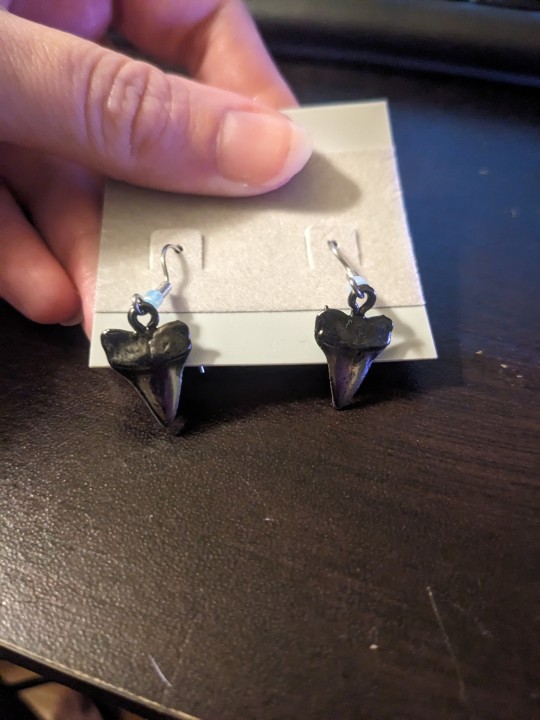
#trilobites#palentology#jewelry#marine invertebrates#marine science#marine biology#i wanna wear these to work tomorrow but i dont wanna get them dirty#he also makes dragon necklaces which I have a couple of#the bull shark earrings are molded from bull shark teeth
183 notes
·
View notes
Text

Jellies!
The SciArt of Ernst Haeckel is unmistakable. These jellies come from Plate 98 of his Kunstformen der Natur (1904).
View more in Biodiversity Heritage Library with thanks to the University Library of the University of Illinois, Urbana-Champaign for digitizing.
#Ernst Haeckel#Jellies#Jellyfish#Marine Life#sea creatures#marine invertebrates#deep sea#sea life#SciArt#moon jellyfish
941 notes
·
View notes
Text
Monterey Bay Aquarium Ctenophores
Hey! Sorry I've been absent - I did a fairly last minute 40-50 hour roundtrip drive to California the past week to go see family (and the @montereybayaquarium ctenophores). I've been wanting to go see the bloody belly comb jellies since the Into the Deep exhibit first opened and I was so excited to finally get down there. I'll be sharing more videos soon, just wanted to let people know I'm back <3
I tried to include at least a little clip of each cteno species they had on display but some came out better than others. I also think I missed getting a clip of Bolinopsis.
Video ID: no audio. A series of ctenophores, starting with the red heart shaped bloody belly comb jelly with flashing rainbow ctenes, with a closeup of the auricles and ctene rows. Another comb jelly, I think maybe Eurhamphea vexilligera, has long narrow auricles tucked into its body and big points near its aboral end. A long pink narrow Beroe abyssicola with a dark stomach swoops through the frame. Leucothea pulchra, the beautiful sea goddess comb jelly, swims in bright blue water. It is covered in golden finger-like protrusions. Another beautiful sea goddess waves its long auricles, and then a third splays its lobes while swimming. Many Homiphora swim and cast out their fishing tentacles. Finally we see a few more shots of the bloody belly comb jellies.
#ctenophore#comb jelly#monterey bay aquarium#aquarium#my marine biology videos#marine biology#marine life#sea creatures#ocean#my videos#marine invertebrates#deep ocean#open ocean
92 notes
·
View notes
Photo

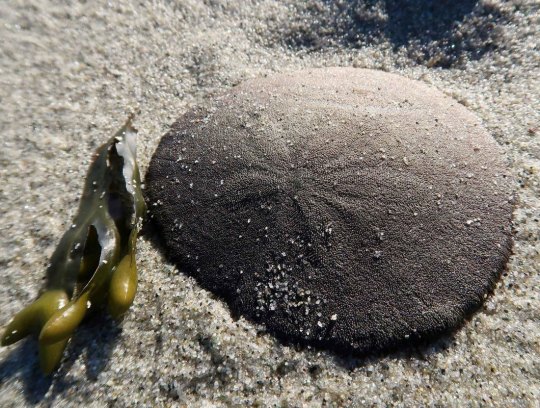
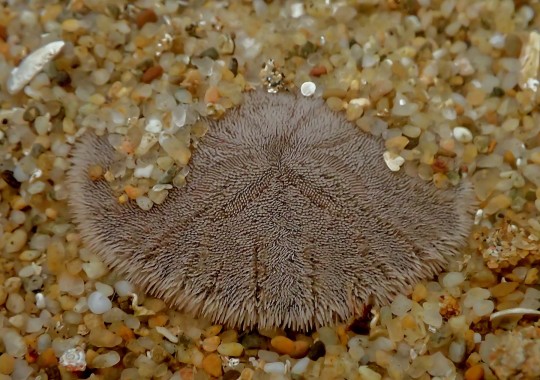
Another Day, Another Pacific Sand Dollar
The eccentric sand dollar, aka the sea-cake, biscuit-urchin, western sand dollar, or Pacific sand dollar (Dendraster excentricus), are found in the intertidal zone and near-shore sandy bottoms from Alaska, US to Baja California, Mexico.They are the only sand dollars endemic to the Pacific Northwest, though they share the rest of their range with other species. Live individuals are seen either partially buried upright or lying flat on the ocean floor, depending on the strength of the current. To prevent themselves from being swept away, juveniles will also ingest sand to weigh themselves down. Although they are not social, they can form large colonies with as many as 6 sand dollars in a square m (1 sq yd).
Pacific sand dollars are named for their resemblance to silver dollars, especially the bleached exoskeletons that commonly wash up on beaches. Most adults average about 8 cm (3 in) across, though individuals as big as 10 cm (4 in) have been found. The body is a flat disc coated in small, purple tube-like feet and sensory organelles called cilia. The feet are used both for moving across the ocean floor and for pulling oxygen from the water. The mouth and anus-- a single opening-- are located on the sand dollar’s underside. Inside the mouth are five teeth and jaw plates known as doves; together they form a structure known as Aristotle’s lantern, which is unique to echinoderms like sand dollars and sea stars.
D. excentricus is a suspension feeder, using its feet and cilia to pull food from the water or direct it along special groves on the body’s underside. Their main prey are microscopic larvae, copepods, diatoms, algae, plankton, and detritus. The sea-cake is predated upon by a number of sea stars and fish, as well as crabs and sea gulls. To avoid being eaten, adults bury themselves in the sand and larvae will duplicate themselves via a process known as budding and fission, which creates smaller individuals that can distract potential predators.
Although western sand dollars have seperate sexes, they are broadcast spawners. In late spring or early summer, males and females congregate and release gametes into the water where they become fertilized. Larvae, also known as prisms, hatch just a day later. This larvae floats freely through the water, growing arms and metamorphosing into a echinopluteus larva. Once they reach 8 arms, the larva begins to develop an exoskeleton or echinus, and resembles a small adult. The final stage of growth is triggered by chemical cues released by other adults; after this, individuals become sexually mature and settle on the ocean with other sand dollars. In the wild, adults can live up to 13 years.
Conservation status: Although the IUCN has not evaluated the Pacific sand dollar, they are regularly threatened by ocean acidification, warming, and bottom trawling.
If you like what I do, consider leaving a tip or buying me a ko-fi!
Photos
Chan Siuman
Brian Starzomski
Alison J. Gong
#pacific sand dollar#Clypeasteroida#Dendrasteridae#sand dollars#echinoderms#invertebrates#marine fauna#marine invertebrates#benthic fauna#benthic invertebrates#intertidal zone#intertidal invertebrates#coasts#coastal invertebrates#Pacific Ocean#North America#western north america
374 notes
·
View notes
Text




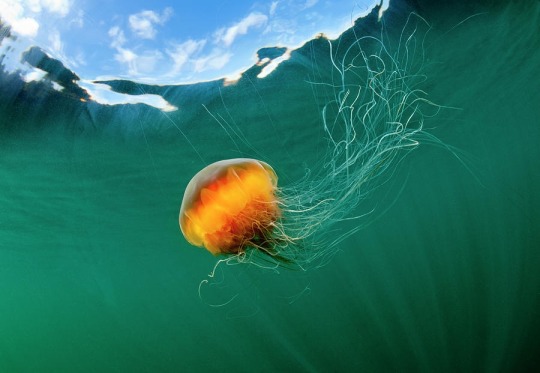

Lion’s Mane Sea Jellies 💜🧡💛
#beauty under the waves#underwater#dive#jellyfish#sea jellies#lions mane jelly#animal#cnidarian#sea animal#sea life#sea creatures#marine#marine animals#marine invertebrates#marine biology#marine life#underwater life#beautiful#pacific#saltwater#ocean#sea
1K notes
·
View notes
Text
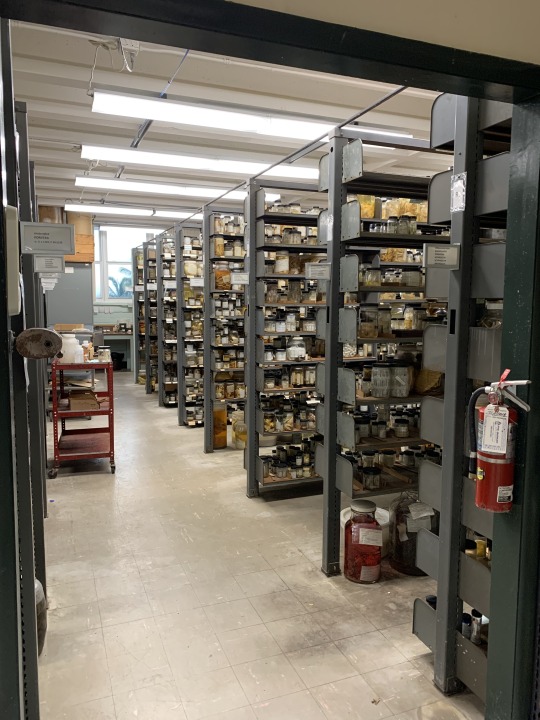
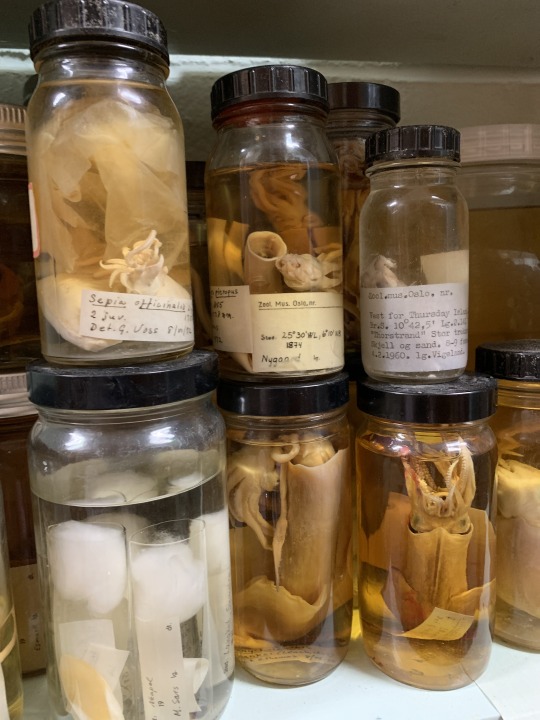



finally got to see my campus’ marine invertebrate collection 𓆨
#🪐.txt#marine biology#marine bio posting#marine invertebrates#the collection is MASSIVE like shelves and shelves and shelves#and when you think there can’t possibly be more: cabinets!!#and then beneath those: drawers!!!#there’s equipment in there copyrighted from 1940#it’s really like a formaldehyde-smelling time capsule#plus we have so many international specimens on loan to study :0#I found it VERY NEAT !!#aes#image ids are in alt text btw!!#bugs#insects#<- sort of ish. tagging in case#giant isopod
79 notes
·
View notes
